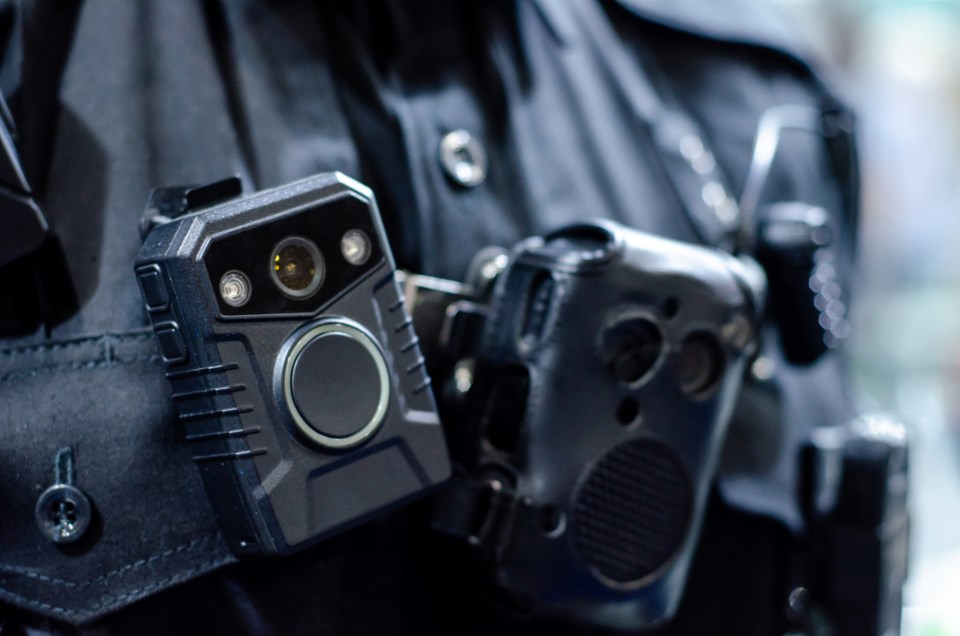REGINA — A special report regarding use of body cameras was presented to the Regina Police Board of Commissioners this week, as the service considers potential benefits of adding the tool to officers’ belts.
Superintendent Trent Stevely shared the highlights of a compiled report with board members on Nov. 23, prompted by a statement from the prime minister that the federal government may soon be pushing to make body cams the norm across Canada.
Stevely’s presentation outlined both the benefits and potential challenges of body cams, which are currently used more widely by police in the United States than counterparts in Canada.
“The use of body worn cameras is multifaceted,” Stevely told the board.
The largest positives of equipping officers with body cams include greater transparency and accountability, which would improve public trust, and evidence capture, said Stevely. The technology can also help improve the mental health of law enforcement members, by eliminating fear of potential slander.
Data from the Calgary Police Service showed that body cams were most beneficial for the purpose of evidence collection, especially during domestic violence calls.
Body camera footage can also aid in internal investigation into use of force complaints, as it provides a complete video of an interaction rather than a shorter version recorded by a member of the public.
“With a body-worn camera, investigators, oversight bodies and crown prosecutors could walk through an entire event and discuss, defend or articulate the actions of all involved, rather than relying on a 10, 20 or 30-second clip,” said Stevely.
The implementation of body cameras was also one of the several recommendations made by the jury at the conclusion of the coroner’s inquest into the death of Geoffrey Morris, which occurred earlier this year.
Challenges, continued Stevely, include privacy laws regarding medical distress calls or around schools and hospitals. Operational concerns are also a large problem, like the cost of the new technology as well as the setup and ongoing maintenance of a camera program.
“The single biggest drawback is the cost,” said Stevely. “Money spent on body worn cameras means less money for programs that might address police transparency in another way.”
The report said that each camera costs an estimated $2,700 plus $100 annually to operate. For every 120 cameras deployed, one additional position is also needed to oversee them, said the Calgary Police Department, in addition to required servers to store data and training for officers to use the technology.
The report also noted that there is “little empirical evidence to support that these devices do in fact increase public trust in police.” In actuality, research suggests the opposite may be true.
“There’s also a significant potential for loss of public trust if body worn cameras or related technology malfunction,” said Stevely.
Chief of Police Evan Bray said that the Regina Police Service does not receive many use of force complaints, meaning that body cam footage would be primarily used as an investigative tool for officers.
As only an estimated 20 per cent of the RPS’s police interactions are criminal in nature, with only 5 per cent moving on to court, Bray said that the need for camera evidence would have to be weighed carefully.
Additionally, the inquest jury’s specific recommendation to have supervising officers wear body cams may not be the best use of the technology, said Bray, as often supervisors aren’t on scene during calls.
“I think we would achieve what those recommendations were hoping to achieve better with a more broad rollout of body worn cameras to frontline officers, who would be the ones dealing face-to-face in those situations,” said Bray.
Bray also noted that the RPS has already implemented some of the other recommendations made following the inquest, including making an Indigenous elder available to individuals in crisis upon request.
If the RPS does invest in body cams, Bray said that the first step would likely be to deploy a small batch to be worn by patrol officers, similar to the Saskatoon Police Service’s incoming rollout plan for the new tech.
The report’s conclusion did not sway Bray in either direction regarding the decision, but the Regina Police Service provided the report upon request to seek the board’s opinion.
Bray also added that he doesn’t feel the RPS is suffering from a widespread issue regarding accountability, but he isn’t against adding more measures if deemed necessary.
“I don’t feel this would be a priority for us right now,” said Bray. “[But] we’re bringing it forward to talk with the board and ultimately come together to provide some direction for where we’re going.”
City councillor Andrew Stevens filed a motion for an additional report from the RPS about other accountability measures currently being used, and potential ways to improve or increase their effectiveness.
The secondary report is expected to be provided to the board by the end of quarter three, in 2022.



